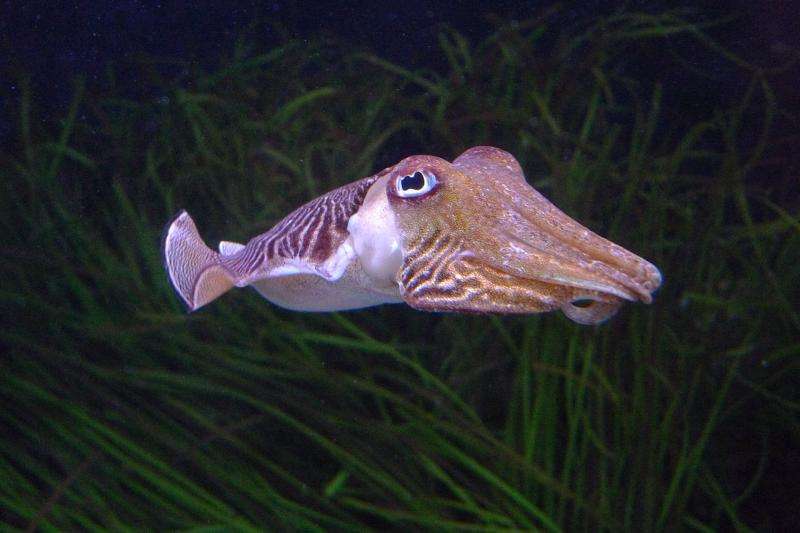Diverse sea creatures evolved to reach same swimming solution

The ability to move one's body rapidly through water is a key to existence for many species on this blue planet of ours. The Persian carpet flatworm, the cuttlefish and the black ghost knifefish look nothing like each other - their last common ancestor lived 550 million years ago, before the Cambrian period - but a new study uses a combination of computer simulations, a robotic fish and video footage of real fish to show that all three aquatic creatures have evolved to swim with elongated fins using the same mechanical motion that optimizes their speed, helping to ensure their survival.
These three animals are part of a very diverse group of aquatic animals - both vertebrate and invertebrate - that independently arrived at the same solution of how to use their fins to maximize speed. And, remarkably, this so-called "convergent" evolution happened at least eight times across three different phyla, or animal groups, supporting the belief that necessity played a larger role than chance in developing this trait. The findings could help scientists better understand evolution as well as help pave the way for highly agile underwater vehicles.
In an article publishing April 28 in the Open Access journal PLOS Biology, the researchers from Northwestern University in Evanston Illinois describe how they studied 22 animals called median/paired fin swimmers, in a wide variety of shapes and sizes. Their elongated fins both undulate, or ripple, lengthwise and oscillate from side to side. For all these animals' fins, the team found that the length of one undulation during swimming divided by the mean amplitude of the sideways movement is always a ratio of around 20.
"Why do you see the same traits, such as the camera-lens eye or wings, in animals that are so different and have no common ancestor with that trait?" asked Malcolm MacIver, a senior author of the study. "It is because there is a finite number of ways to really do something well. In our study, we have quantified how an unusual group of swimming animals optimizes force and, therefore, speed."
Evolution pushes nature toward more organized solutions and less disorder, the researchers say. Their goal was to quantify biology and its solutions, not just make observations.
"Technically, it's chance versus physics," said Neelesh A. Patankar, a close collaborator of MacIver's and the study's other senior author. "Chance offers many possibilities as to how a fish can swim, but physics and the animal's environment puts constraints on these possibilities. In this case, the selection pressure is very high, pushing the animal to one particular solution, and necessity triumphs."
MacIver, associate professor of mechanical and of biomedical engineering, and Patankar, a theorist and professor of mechanical engineering, worked closely together on the study. Both are faculty members in the McCormick School of Engineering and Applied Science, Northwestern University.
The research team is one of very few to quantify the mechanical basis (maximizing propulsive force or speed) for a case of convergent evolution, where similar features evolve in unrelated organisms as adaptations to similar lifestyles and environments, such as wings in both birds and bats.
The researchers call the recurring ratio of 20 the "optimal specific wavelength" (OSW). In their study, they did not find a single exception, and they expect that the additional 1,000 species that swim in this way (median/paired fin swimmers) but that have not yet been measured also will adhere to the OSW.
"Chance does play a role in these animals—they don't all adhere exactly to the optimal number 20—but there is a point where variability can become deadly, that swimming with the wrong mechanics means you waste energy and won't survive," MacIver said. "The ratio of 20 is best."
Key Findings:
- Elongated fins use same mechanical motion to optimize speed across eight animal groups
- Necessity triumphed over chance in developing vital trait, researchers say
- Rare instance of quantifying mechanical basis for convergent evolution
- Study furthers understanding of interaction between chance and necessity in biology
- Important engineering implications for next generation of underwater vehicles
More information: Bale R, Neveln ID, Bhalla APS, MacIver MA, Patankar NA (2015) Convergent Evolution of Mechanically Optimal Locomotion in Aquatic Invertebrates and Vertebrates. PLoS Biol 13(4): e1002123. DOI: 10.1371/journal.pbio.1002123
Journal information: PLoS Biology
Provided by Public Library of Science


















